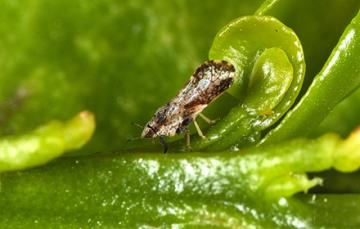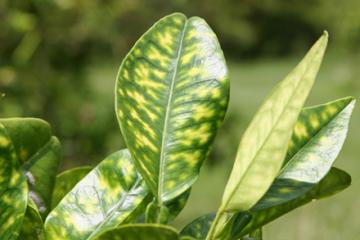New Traps Cut Off Citrus Greening Pests from Hiding Places

Adult Asian citrus psyllid, Diaphorina citri, (2-3 millimeters long) on a young citrus leaf. The psyllid carries the bacterium thought to be the causal agent of Huanglongbing in its salivary glands. As it feeds on citrus leaves, the psyllid transmits the bacterium to the tree. The result is yellowed leaves, bitter fruit, and eventual tree death. (David Hall, D595-1)
Researchers across the nation are struggling to end the scourge of citrus greening disease, also known as huanglongbing. The disease renders citrus fruit inedible and eventually kills entire orchards. In Florida alone, from 2012-2016 the disease caused production losses of $4.4 billion and eliminated about 7,900 jobs.
With economic impact like that, it’s no wonder that previous citrus greening research and mitigation efforts have mainly focused on commercial production. Now, researchers with the Agricultural Research Service’s (ARS) Horticultural Research Laboratory in Fort Pierce, FL, and their collaborators are bringing the citrus greening fight to the suburbs, where citrus trees are popular landscape plantings.
The Asian citrus psyllid, an insect about the size of an aphid (roughly 1/8 of an inch), carries the bacterium Candidatus Liberibacter asiaticus in its salivary glands. As it feeds on citrus leaves, the psyllid transmits the bacterium to the tree. The bacterium then prevents sugars created through photosynthesis from traveling throughout the tree. The result is yellowed leaves, bitter fruit, and eventual tree death.
Spraying insecticides is not really an option in residential areas because many homeowners either have concerns about insecticides or find it too difficult to adequately treat backyard trees, said ARS research entomologist Joseph Patt.

Leaves of an orange tree infected with Huanglongbing, or citrus greening. The blotchy mottling pattern seen here, along with thickening, are characteristic symptoms of infected leaves. (Tim Gottwald, D2259-1)
“There are virtually no control measures being taken against psyllids in citrus trees growing in residential and commercial landscapes,” he said. “This is important because the psyllid can fly from residential areas to commercial citrus groves. In other words, residential areas provide a kind of refuge for the psyllids because homeowners haven’t had a way to control them in their backyard trees.”
Patt and Texas A&M-Kingsville entomologists Andrew Chow and Mamoudou Setamou developed “attract-and-kill” traps to prevent this hide-and-seek, back-and-forth migration of psyllids. The traps, which are hung from citrus trees, are the same color as young citrus foliage and contain a fast-acting insecticide that kills the psyllid. According to Patt, the traps provide an environmentally friendly way for homeowners to help control Asian citrus psyllid and citrus greening disease. The insecticide remains in the device and does not spread to the surrounding foliage. The active ingredient is not toxic to mammals or birds and does not persist in the environment.
Initial testing was completed last year in the Rio Grande region of Texas. “The results are promising,” Patt said. “Deployment of 20 attract-and-kill devices per test tree resulted in a 90-percent decrease in psyllid eggs compared to unprotected test trees. We are currently working on a design for use in commercial citrus. Psyllids invade citrus groves by first landing in the trees growing along the edge of the grove, so we will run tests to determine if devices placed only on border trees are effective in controlling the psyllid throughout the grove.” – by Scott Elliott, ARS Office of Communications.
You May Also Like

